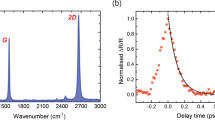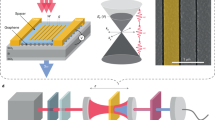Abstract
The unique linear and massless band structure of graphene in a purely two-dimensional Dirac fermionic structure has led to intense research in fields ranging from condensed matter physics to nanoscale device applications covering the electrical, thermal, mechanical and optical domains. Here, we report three consecutive first observations in graphene–silicon hybrid optoelectronic devices—ultralow-power resonant optical bistability, self-induced regenerative oscillations and coherent four-wave mixing—all at few-femtojoule cavity recirculating energies. These observations, in comparison with control measurements on solely monolithic silicon cavities, are enabled only by the dramatically large and ultrafast χ(3) nonlinearities in graphene and the large Q/V ratios in wavelength-localized photonic crystal cavities. These third-order nonlinear results demonstrate the feasibility and versatility of hybrid two-dimensional graphene–silicon nanophotonic devices for next-generation chip-scale high-speed optical communications, radiofrequency optoelectronics and all-optical signal processing.
This is a preview of subscription content, access via your institution
Access options
Subscribe to this journal
Receive 12 print issues and online access
$209.00 per year
only $17.42 per issue
Buy this article
- Purchase on Springer Link
- Instant access to full article PDF
Prices may be subject to local taxes which are calculated during checkout




Similar content being viewed by others
References
Xu, Q., Schmidt, B., Pradhan, S. & Lipson, M. Micrometre-scale silicon electro-optic modulator. Nature 435, 325–327 (2005).
Liu, A. et al. A high-speed silicon optical modulator based on a metal–oxide–semiconductor capacitor. Nature 427, 615–618 (2005).
Liu, J. et al. Waveguide-integrated, ultralow-energy GeSi electro-absorption modulators. Nature Photon. 2, 433–437 (2008).
Kuo, Y.-H. et al. Strong quantum-confined Stark effect in germanium quantum-well structures on silicon. Nature 437, 1334–1336 (2005).
Assefa, S., Xia, F. & Vlasov, Y. A. Reinventing germanium avalanche photodetector for nanophotonic on-chip optical interconnects. Nature 464, 80–84 (2010).
Kang, Y. et al. Monolithic germanium/silicon avalanche photodiodes with 340 GHz gain–bandwidth product. Nature Photon. 3, 59–63 (2009).
Biberman, A. et al. First demonstration of long-haul transmission using silicon microring modulators. Opt. Express 18, 15544–15552 (2010).
Pelusi, M. et al. Photonic-chip-based radio-frequency spectrum analyser with terahertz bandwidth. Nature Photon. 3, 139–143 (2009).
Colman, P. et al. Temporal solitons and pulse compression in photonic crystal waveguides. Nature Photon. 4, 862–868 (2010).
Morichetti, F. et al. Travelling-wave resonant four-wave mixing breaks the limits of cavity-enhanced all-optical wavelength conversion. Nature Commun. 2, 296 (2011).
Foster, M. et al. Silicon-chip-based ultrafast optical oscilloscope. Nature 456, 81–84 (2008).
Pasquazi, A. M. et al. Sub-picosecond phase-sensitive optical pulse characterization on a chip. Nature Photon. 5, 618–623 (2011).
Zhang, Y., Tan, Y.-W., Stormer, H. L. & Kim, P. Experimental observation of the quantum Hall effect and Berry's phase in graphene. Nature 438, 201–204 (2005).
Geim, A. K. & Novoselov, K. S. The rise of graphene. Nature Mater. 6, 183–191 (2007).
Du, X. et al. Fractional quantum Hall effect and insulating phase of Dirac electrons in graphene. Nature 462, 192–195 (2009).
Dean, C. R. et al. Multicomponent fractional quantum Hall effect in graphene. Nature Phys. 7, 693–696 (2011).
Berger, C. et al. Electronic confinement and coherence in patterned epitaxial graphene. Science 312, 1191–1196 (2006).
Meric, I. et al. Current saturation in zero-bandgap, top-gated graphene field-effect transistors. Nature Nanotech. 3, 654–659 (2008).
Lin, Y.-M. et al. 100-GHz transistors from wafer-scale epitaxial graphene. Science 327, 662 (2010).
Seol, J. H. et al. Two-dimensional phonon transport in supported graphene. Science 328, 213–216 (2010).
Gabor, N. M. et al. Hot carrier-assisted intrinsic photoresponse in graphene. Science 334, 648–652 (2011).
Lee, C., Wei, X., Kysar, J. W. & Hone, J. Measurement of the elastic properties and intrinsic strength of monolayer graphene. Science 321, 385–388 (2008).
Bonaccorso, F., Sun, Z., Hasan, T. & Ferrari, A. C. Graphene photonics and optoelectronics. Nature Photon. 4, 611–622 (2010).
Chen, C.-F. et al. Controlling inelastic light scattering quantum pathways in graphene. Nature 471, 617–620 (2011).
Wang, F. et al. Gate-variable optical transitions in graphene. Science 320, 206–209 (2008).
Li, Z. Q. et al. Dirac charge dynamics in graphene by infrared spectroscopy. Nature Phys. 4, 532–535 (2008).
Liu, M. et al. A graphene-based broadband optical modulator. Nature 474, 64–67 (2011).
Mueller, T., Xia, F. & Avouris, P. Graphene photodetectors for high-speed optical communications. Nature Photon. 4, 297–301 (2010).
Xia, F. et al. Ultrafast graphene photodetector. Nature Nanotech. 4, 839–843 (2009).
Engel, M. et al. Light–matter interaction in a microcavity-controlled graphene transistor. Nature Commun. 3, 906 (2012).
Furchi, M. et al. Microcavity-integrated graphene photodetector. Nano Lett. 12, 2773–2777 (2012).
Sun, Z. et al. Graphene mode-locked ultrafast laser. ACS Nano 4, 803–810 (2010).
Hendry, E. et al. Coherent nonlinear optical response of graphene. Phys. Rev. Lett. 105, 097401 (2010).
Li, X. et al. Large-area synthesis of high-quality and uniform graphene films on copper foils. Science 324, 1312–1314 (2009).
Bae, S. et al. Roll-to-roll production of 30-inch graphene films for transparent electrodes. Nature Nanotech. 5, 574–578 (2010).
Lin, Y.-M. et al. Wafer-scale graphene integrated circuit. Science 332, 1294–1297 (2011).
Akahane, Y., Asano, T., Song, B. & Noda S. High-Q photonic nanocavity in a two-dimensional photonic crystal. Nature 425, 944–947 (2003).
Yang, X., Yu, M., Kwong, D.-L. & Wong, C. W. All-optical analogue to electromagnetically induced transparency in multiple coupled photonic crystal cavities. Phys. Rev. Lett. 102, 173902 (2009).
Dean, C. R. et al. Boron nitride substrate for high-quality graphene electronics. Nature Nanotech. 5, 722–726 (2010).
Petrone, N. et al. High-mobility scalable graphene by large-grain chemical vapor deposition growth. Nano Lett. 12, 2751–2756 (2012).
Zhao, W., Tan, P. H., Liu, J. & Ferrari, A. C., Intercalation of few-layer graphite flakes with FeCl3: Raman determination of Fermi level, layer by layer decoupling and stability. J. Am. Chem. Soc. 133, 5941–5946 (2011).
Jablan, M., Buljan, H. & Soljačić, M. Plasmonics in graphene at infrared frequencies. Phys. Rev. B 80, 245435 (2009).
Bao, Q. et al. Broadband graphene polarizer. Nature Photon. 5, 411–415 (2011).
Armaroli, A. et al. Oscillatory dynamics in nanocavities with noninstantaneous Kerr response. Phys. Rev. A 84, 053816 (2011).
Johnson, T. J., Borselli, M. & Painter, O. Self-induced optical modulation of the transmission through a high-Q silicon microdisk resonator. Opt. Express 14, 817–831 (2006).
Acknowledgements
The authors acknowledge valuable discussions with T.F. Heinz, as well as helpful suggestions from A. Gondarenko, F. Gesuele, Y. Li, J. Lui and J. Yang. The authors acknowledge funding support from NSF IGERT (DGE-1069240) and the Center for Re-Defining Photovoltaic Efficiency through Molecule Scale Control, an Energy Frontier Research Center funded by the US Department of Energy, Office of Science, Office of Basic Energy Sciences (award no. DE-SC0001085).
Author information
Authors and Affiliations
Contributions
T.G. and J.F.M. performed the experiments. T.G., N.P., A.V.D.Z. and J.H. prepared the graphene transfer and synthesis. M.Y., G.Q.L. and D.L.K. nanofabricated the membrane samples. T.G. and C.W.W. performed the numerical simulations. T.G. and C.W.W. prepared the manuscript.
Corresponding authors
Ethics declarations
Competing interests
The authors declare no competing financial interests.
Supplementary information
Supplementary information
Supplementary information (PDF 2134 kb)
Rights and permissions
About this article
Cite this article
Gu, T., Petrone, N., McMillan, J. et al. Regenerative oscillation and four-wave mixing in graphene optoelectronics. Nature Photon 6, 554–559 (2012). https://doi.org/10.1038/nphoton.2012.147
Received:
Accepted:
Published:
Issue Date:
DOI: https://doi.org/10.1038/nphoton.2012.147
This article is cited by
-
Strong second-harmonic generation by sublattice polarization in non-uniformly strained monolayer graphene
Nature Communications (2023)
-
An on-Si directional second harmonic generation amplifier for MoS2/WS2 heterostructure
Nano Research (2023)
-
Quantum coherence-assisted secure communication of internet of things information via Landau-quantized graphene
Optical and Quantum Electronics (2023)
-
Controlling the threshold voltage of a semiconductor field-effect transistor by gating its graphene gate
npj 2D Materials and Applications (2022)
-
Graphene-integrated waveguides: Properties, preparation, and applications
Nano Research (2022)



